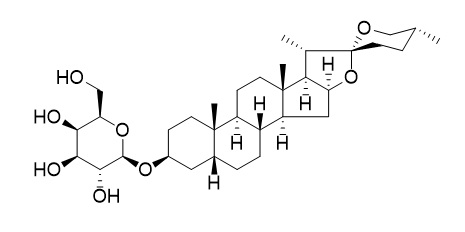Timosaponin AI
Timosaponin AI can inhibit dipeptidyl peptidase-4 (DPP-4) activity in a dose-dependent manner, the DPP-4 inhibitor has been clinically used for the treatment of type 2 diabetes mellitus.
Inquire / Order:
manager@chemfaces.com
Technical Inquiries:
service@chemfaces.com
Tel:
+86-27-84237783
Fax:
+86-27-84254680
Address:
1 Building, No. 83, CheCheng Rd., Wuhan Economic and Technological Development Zone, Wuhan, Hubei 430056, PRC
Providing storage is as stated on the product vial and the vial is kept tightly sealed, the product can be stored for up to
24 months(2-8C).
Wherever possible, you should prepare and use solutions on the same day. However, if you need to make up stock solutions in advance, we recommend that you store the solution as aliquots in tightly sealed vials at -20C. Generally, these will be useable for up to two weeks. Before use, and prior to opening the vial we recommend that you allow your product to equilibrate to room temperature for at least 1 hour.
Need more advice on solubility, usage and handling? Please email to: service@chemfaces.com
The packaging of the product may have turned upside down during transportation, resulting in the natural compounds adhering to the neck or cap of the vial. take the vial out of its packaging and gently shake to let the compounds fall to the bottom of the vial. for liquid products, centrifuge at 200-500 RPM to gather the liquid at the bottom of the vial. try to avoid loss or contamination during handling.
Front Pharmacol.2022, 13:870553.
Front Immunol. 2020, 11:62.
ACS Omega.2021, 6(36):23460-23474.
Molecules2022, 27(11):3606.
Plants (Basel).2021, 10(6):1119.
Biochem Biophys Rep.2024, 40:101830.
Journal of Ginseng Research2022, j.jgr.2022.09.005.
Plant Cell.2024, 158: 62.
Nutrients.2020, 12(11):3448.
Int J Biol Macromol.2020, 161:1230-1239.
Related and Featured Products
Zhongguo Zhong Yao Za Zhi. 2016 Apr;41(7):1241-1245.
Screening and identification of DPP-4 inhibitors from Xiaokean formula by a fluorescent probe.[Pubmed:
28879738]
Fluorescent bio-probes have attracted increasing attentions in studies for screening bioactive compounds from traditional Chinese medicines.
METHODS AND RESULTS:
In this study, a new-type fluorescent probe with the function of aggregation-induced emission (AIE) was used to screen dipeptidyl peptidase-4 (DPP-4) inhibitor from Xiaokean formula, which has been clinically used for the treatment of type 2 diabetes mellitus.
Potential DPP-4 inhibitors were screened by the fluorescent probe, with diprotin A as the positive control; totally 43 components were isolated from Xiaokean formula by systematic separation. The results showed that 13 components can exert inhibitory effects on DPP-4 activity; 16 compounds were further identified by liquid chromatography-mass spectrometry (LC-MS) from those active components. The inhibitory effects of 14 compounds were further verified, while five of them showed significant inhibition against DPP-4. Salvianolicacid C, ginsenoside Rg₅ and Timosaponin AI inhibited DPP-4 activity at the concentration of 5-50 μmol•L⁻1 in a dose-dependent manner.
CONCLUSIONS:
Thus, our study provided a successful example for screening bioactive compounds from traditional Chinese medicines by using a novelfluorescent probe.
Process Biochemistry, 2015, 50(12):2182-2187.
Preparation of some metabolites of Timosaponin BII by biotransformation in vitro.[Reference:
WebLink]
Timosaponin BII (TBII) is an active constituent of some Chinese medicinal herbs, and is abundant in Anemarrhena asphodeloides Bunge.
METHODS AND RESULTS:
To better understand the pharmaceutical mechanisms of TBII, we prepared its deglycosylated derivatives through biotransformation with fungi Colletotrichum gloeosporioides, Acremonium alternatum and Aspergillus niger. In the presence of 10. g/L glucose, transformation with C. gloeosporioides yielded 4 products: Timosaponin AIII (P3) and Timosaponin AI (P5) and their beta isoforms (P2 and P4 respectively). However, P4 and P5 could not be detected when 0-5. g/L glucose was applied; P2 and P3 disappeared at 20. g/L glucose. P4 is a newly discovered compound.
CONCLUSIONS:
We firstly report that fungi in whole cell model can hydrolyze C3-. O-glucopyranosyl residues of steroidal saponins after removing the C26 sugar. Therefore, the transformation efficiency depends on glucose. Transformation of TBII, and maybe other steroidal saponins, with C. gloeosporioides is an ideal method to prepare the metabolites in vitro.



